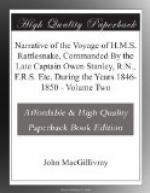Mr. Eyre believes that there are “grounds sufficient to hazard the opinion that Australia was first peopled on its north-western coast, between the parallels of 12 and 16 degrees South latitude. From whence we might surmise that three grand divisions had branched off from the parent tribe, and that from the offsets of these the whole continent has been overspread."* Proceeding still further Mr. Eyre has very ingeniously attempted to explain the gradual peopling of Australia, and even indicate the probable routes taken by the first settlers during the long periods of years which must have elapsed before the whole continent was overrun by the tribes now collectively forming the Australian race. Dr. Prichard, when alluding to the probable mode of dispersion of the black tribes of the Indian Archipelago, conjectures that one of the branches during the migratory march probably passed from Java to Timor, and from thence to Australia.** Dr. Latham also inclines to the belief that Australia was peopled from Timor and not from New Guinea, judging, in the absence of positive proof, from the probability that “occupancy had begun in Australia before migration across Torres Strait had commenced in New Guinea,” inferred “from the physical differences between the Australian and the Papuan, taken with the fact that it is scarcely likely that the Papuans of Torres Strait would have failed in extending themselves in Australia had that island been unoccupied.” Timor also is much nearer than New Guinea to the REMOTE source—assumed to be the continent of Asia—whence the Australians have been derived.***
(Footnote. Journals of Expeditions of Discovery into Central Australia etc. by E.J. Eyre Volume 2 page 405.)
(**Footnote. Researches into the Physical History of Mankind Volume 5 page 214.)
(***Footnote. Natural History of the Varieties of Man by R.G. Latham, M.D. pages 257 and 253.)
The unity of the Australian race being admitted implies one common origin, and that such was not derived from New Guinea, can scarcely, I think, be doubted. Upon examining the neighbourhood of the point of contact between the New Guinea-men and the Australians, we find Cape York and the neighbouring shores of the mainland occupied by genuine and unmixed Australians, and the islands of Torres Strait with the adjacent coast of New Guinea by equally genuine Papuans; intermediate in position between the two races, and occupying the point of junction at the Prince of Wales Islands we find the Kowrarega tribe of blacks. At first I was inclined to regard the last more as degraded Papuans than as improved Australians: I am now, however, fully convinced that they afford an example of an Australian tribe so altered by contact with the Papuan tribes of the adjacent islands as at length to resemble the latter in most of their physical, intellectual and moral characteristics. Thus the Kowraregas have acquired from their island neighbours the art




